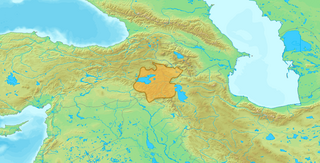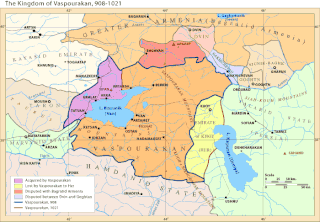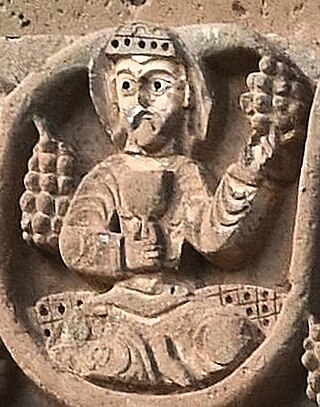
The Artsrunis were an ancient princely and, later, royal dynasty of Armenia.

Smbat I, sometimes Smbat A Martyr was the second king of the medieval Kingdom of Armenia of the Bagratuni dynasty, and son of Ashot I. He is the father of Ashot II and Abas I.
Vaspurakan was the eighth province of the ancient kingdom of Armenia, which later became an independent kingdom during the Middle Ages, centered on Lake Van. Located in what is now southeastern Turkey and northwestern Iran, the region is considered to be the cradle of Armenian civilization.
Ashot I was a king of Armenia who oversaw the beginning of Armenia's second golden age. He was the son of Smbat VIII the Confessor and was a member of the Bagratuni dynasty.

Gagik II was the last Armenian king of the Bagratuni dynasty, ruling in Ani from 1042 to 1045.

Gagik I was a Bagratid king of Armenia who reigned between 989 and 1020, under whom Bagratid Armenia reached its height and enjoyed a period of uninterrupted peace and prosperity.
Gagik is a common Armenian name. It may refer to:

Tovma Artsruni was a ninth- to tenth-century Armenian historian who authored the History of the House of Artsrunik. Despite its title, the four-volume work not only relates the history of the Artsruni royal family, of which Tovma was a member, but also comprehensively covers the history of Armenia.

Bagratid Armenia was an independent Armenian state established by Ashot I of the Bagratuni dynasty in the early 880s following nearly two centuries of foreign domination of Greater Armenia under Arab Umayyad and Abbasid rule. With each of the two contemporary powers in the region—the Abbasids and Byzantines—too preoccupied to concentrate their forces on subjugating the region, and with the dissipation of several of the Armenian nakharar noble families, Ashot succeeded in asserting himself as the leading figure of a movement to dislodge the Arabs from Armenia.

The Kaysite dynasty was a Muslim Arab dynasty that ruled an emirate centered in Manzikert from c. 860 until 964. Their state was the most powerful Arab amirate in Armenia after the collapse of the ostikanate of Arminiya in the late 9th century.

Karmravank is an abandoned 10th century Armenian monastery in the Vaspurakan province of historic Armenia. It was founded by King Gagik I (908-943) of the Artsruni dynasty. It is located 12 kilometers west-northwest of Akhtamar Island.
The Church of the Holy Cross at Soradir is a 6th-century Armenian monastic complex in south-eastern Turkey. It is situated in the village of Yanal near the town and district of Başkale in Van Province.
The Monastery of Saint George of Goms was an Armenian monastery in the historic province of Vaspurakan, in present-day Turkey. The local Armenian peasants called it Jojglukh vank. Goms, meaning "cowsheds", was the name of the nearest village to the monastery: this village is now called Kümüs by its Kurdish inhabitants, its official name is Çanakdüzü.

The Kingdom of Vaspurakan was a medieval Armenian kingdom centered on Lake Van, located in what is now eastern Turkey and northwestern Iran. It was named after Vaspurakan, a province of historic Greater Armenia. Ruled by the Artsruni dynasty, it competed and cooperated with the Bagratuni-ruled Kingdom of Armenia for a little over a century until its last king ceded the kingdom to the Byzantine Empire in 1021.

Gagik I Artsruni was an Armenian noble of the Artsruni dynasty who ruled over Vaspurakan in southern Armenia, first as prince of northwestern Vaspurakan and after that until his death as King of Vaspurakan, also claiming the title of King of Armenia.

Derenik-Ashot Artsruni was the second King of Vaspurakan, from the Artsruni dynasty, succeeding his father, Gagik I, on the latter's death. He died childless in 958/959 and was succeeded by his younger brother Abusahl-Hamazasp.

The Bagratuni or Bagratid dynasty was an Armenian royal dynasty which ruled the medieval Kingdom of Armenia from c. 885 until 1045. Originating as vassals of the Kingdom of Armenia of antiquity, they rose to become the most prominent Armenian noble family during the period of Arab rule in Armenia, eventually establishing their own independent kingdom. Their domain included regions of Armenia such as Shirak, Bagrevand, Kogovit, Syunik, Lori, Vaspurakan, Vanand and Taron. Many historians, such as Cyril Toumanoff, Nicholas Adontz and Ronald Suny, consider them to be the progenitors of the Georgian royal Bagrationi dynasty.
Artsruni, an ancient Armenian noble family.
The Bagratuni family tree describes the heritage of the Bagratuni family in Armenia. Bagratuni lineage also lays claim to the Georgian Bagrationi dynasty.